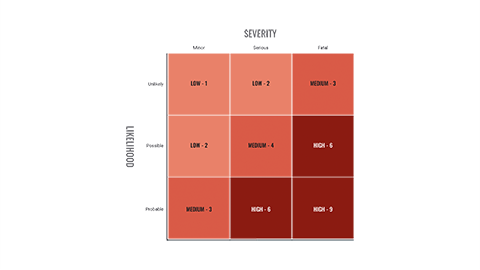In this topic, we focus on your role within Health and Safety in your daily practice. You will learn:
- What Health and Safety encompasses
- How to construct and conduct a risk assessment
- How to respond to accidents and emergencies
- Your responsibilities as a fitness professional
Terminology and vocabulary reference guide
As an allied health professional, you need to be familiar with terms associated with basic exercise principles and use the terms correctly (and confidently) with clients, your colleagues, and other allied health professionals. You will be introduced to many terms and definitions. Add any unfamiliar terms to your own vocabulary reference guide.
Activities
There are activities throughout the topic and an end of the topic automated quiz. These are not part of your assessment but will provide practical experience that will help you in your work and help you prepare for your formal assessment.
The Heath and Safety at Work Act (2015) is New Zealand’s workplace health and safety law which serves to protect employees and non-employees by reducing the rate or injury and deaths which take place within the New Zealand workforce.
It is the responsibility of all to ensure their actions or lack of actions, i.e. what they do or don’t do, does not cause harm to themselves or others.
There are two factors to consider when assessing potential harm to an individual:
- Hazard: something which has the ability to cause harm
- Risk: the chance (low, medium or high) that the hazard will cause harm
Hazards come in all shapes and sizes. Within the fitness industry, examples of these are (but not limited to):
- Step-up boxes, dumbbells/gym equipment left on the floor
- Loose cables
- Loud music
- Performing an exercise incorrectly
- Office equipment (stapler, keyboard, pen/pencil).
Risk assessment process
Risk assessment is a continual process by which all potential hazards to assets of individuals should be identified and their risks evaluated, determine how to eliminate the hazard or control the risk posed by the hazard should it not be possible to eliminate it. By implementing and conducting a risk assessment, a safer and healthier working environment is established for all.

- Hazard Identification: What are your hazards? Have you made a comprehensive list of all possible hazards?
- Risk Analysis: What risks to your hazards pose and how likely are they to occur?
- Risk Evaluation: Some risks will cause major disruptions, some will have minor outcomes. Some may pose risks to just an individual or also cause an effect on the business also. In this process, it is necessary to develop a plan as to what will be required to be done to control the risk and who is required in order to achieve this.
- Elimination/control of the hazard: Ideally, you would want to eliminate all possible risks from occurring, sadly however, this is not always possible, therefor, your next aim would be to identify those which cannot be completely eliminated and determine an appropriate strategy which results in reducing the risk to the lowest possible level.
The aim of a risk assessment is to be able to answer the following questions:
- what can happen?
- under what circumstances would/could these events occur?
- what are all possible consequences?
- what is the likelihood of these consequences?
- what actions are required to eliminate the risk
- should complete elimination not be possible, what steps must be taken to minimise the risk(s)
- who would/should be involved in the process?
- are all parties aware and in agrees of their roles and the processes required?
Note: Risk analysis is a process which requires continual evaluation to ensure any new risks have been identified and that the initial evaluation process was effective and if not, continue to clarify and add any new steps which would be required for effective hazard control. Risk analysis involves monitoring, re-evaluation and compliance from all persons involved in decision making as well as the overall process.
When should a risk assessment be done?
As discussed, this is not a onetime process, nor is it a one-size-fits-all approach. There are many reasons which would require a risk analysis to be conducted and or re-evaluated, such as:
- When hazards are identified
- Before changes are introduced to existing process or activities
- When new information pertaining to possible harm becomes available
- Before new activities are introduced.
Risk assessment plan
When noting hazards and determining their risk level, this is noted in a risk assessment plan. Within this plan, all hazards are noted, their foreseeable risk as rated, estimating impact and an action guide as to how to respond to the risks. Ideally, you wish to completely eliminate all hazards, but practicably, this may not always be possible, therefor there must be an action plan for you, your team, or your exercise facility to follow in order to ensure minimal impact is achieved along with outlining what to do should action be required.
There are various templates that you can use or create to document the hazards and their risk in a manner which is suitable for yourself and your team/facility.

How to rank risks
There is no one approach to ranking or prioritising risks, similarly, there is no single process or technique which will apply to all situation, therefor it is important to develop a risk assessment plan in conjunction with others. You may also refer to material such as manufacturer's guides, industry best practice, ethical conduct policies, advice from a health and safety expert as well as other tools.
When constructing your risk assessment plan, you will look at each risk in terms of severity and likelihood, let us explore these in more depth below:
Severity
Severity is typically viewed as either low, medium, or high.
- Low: where an injury would require first aid only, dizziness, minor irritation, or short-term pain
- Medium: Where an injury would require time off work, typically a few days only. Such as (but not limited to) a sprain or strain or asthma for example.
- High: Where an injury is or could be fatal, or results in outcomes such as (but not limited to) significant blood loss, poisoning, a major fracture, a serious head injury, a significant impact to organs, or a fatal infection/disease.
Likelihood
Likelihood, also termed as probability, is typically also viewed as low, medium or high or can also be described as unlikely, possible, or probable.
- Low (unlikely): may occur, however perhaps once or twice only by an individual or an institution in a lifetime.
- Medium (possible): possible to occur, somewhere one to five times by an individual or an institution.
- High (probable): possible for frequent or definite occurrence by an individual or an institution.
Risk rating
Risk rating is generally depicted by colour coding indicating recommended actions required, this can be determined by your institution and the individuals involved in the risk process. Such examples could be:

- Immediate danger: resulting in an activity or process being ceased immediately and intervention controls implemented immediately.
- High risk: investigate the action or process and intervention controls implemented immediately.
- Medium risk: process or action can continue however controls are required to be developed and implemented as soon as possible in order to prevent serious implications from occurring and prior to the escalation of the nature of the risk.
- Low risk: process or action can continue however this should be monitored regularly along with the investigation and or development of control factors.
- Very low risk: continue to monitor the action or process and amend risk rating if and where required.

Proper prior planning prevents poor performance.
Hazards and risks are in every aspect of your role as an exercise professional and as has been outlined, it is key that you are aware of all and have a plan in place of how to deal with these events should they occur. Proper prior planning will enable you to eliminate some and reduce those which cannot be eliminated but as the term implies, ‘accidents’ will still occur and it is essential, as per both your code of conduct and ethical practice as well as your duty of care, that you are both aware and confident as to how to handle these situations when they occur.
Accidents and emergencies can and will come in all shapes in sizes in the fitness industry from a lightbulb in an exercise area going out to a client or a colleague having an asthma attack to someone injuring themselves on a piece of equipment.
As an exercise professional you are required to hold a current insurance certificate along with a valid first aid qualification which outlines steps to be taken in the event of an accident and emergency from a medical standpoint. The fitness establishment you work for will also have its own procedures and outline clearly who to contact and what steps to take in order to action situations as they occur. It is your responsibility as an exercise professional to ensure you are fully aware of these and that you follow them correctly. Failure to do so in some circumstances can result in either timely delay of business activities and, worst-case scenario, liability for the serious injury or death of another individual.
In this topic, we focused on your role within Health and Safety in your daily practice. You learnt about:
- What Health and Safety encompasses
- How to construct and conduct a risk assessment
- How to respond to accidents and emergencies
- Your responsibilities as a fitness professional
WARNING
This material has been reproduced and communicated to you by or on behalf of UP Education in accordance with section 113P of the Copyright Act 1968 ( the Act ).
The material in this communication may be subject to copyright under the Act. Any further reproduction or communication of this material by you may be the subject of copyright protection under the Act.
Do not remove this notice.
WARNING
This material has been reproduced and communicated to you by or on behalf of UP Education in accordance with section 113P of the Copyright Act 1968 ( the Act ).
The material in this communication may be subject to copyright under the Act. Any further reproduction or communication of this material by you may be the subject of copyright protection under the Act.
Do not remove this notice.

